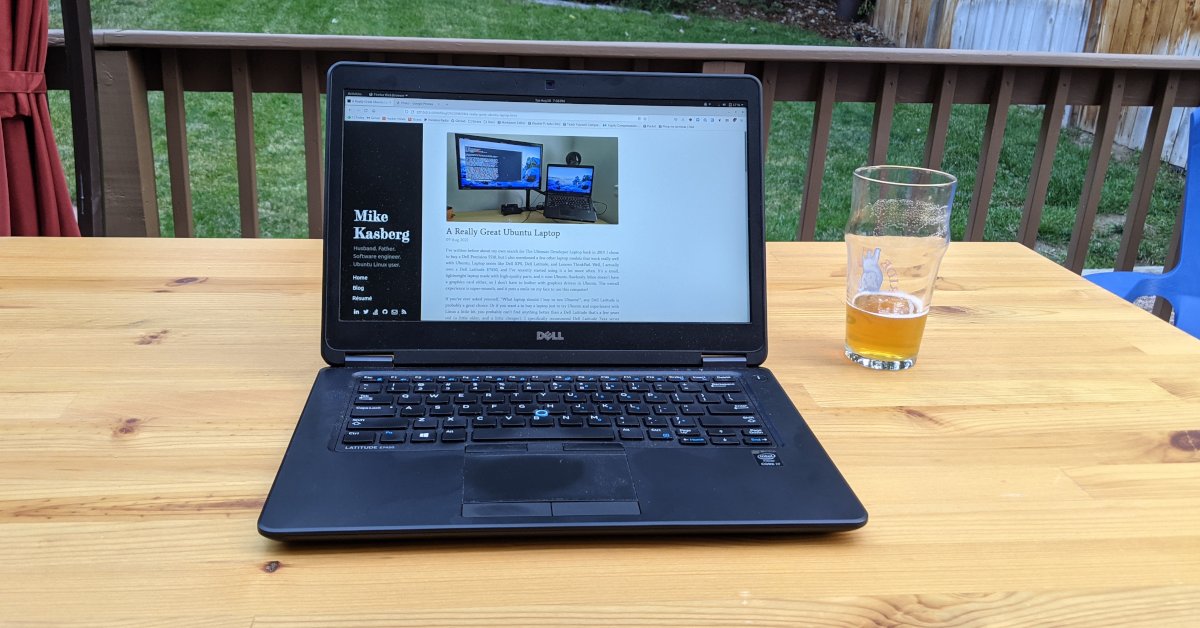
Dell Latitudes are Great Laptops (and they run Ubuntu well)
I’ve written before about my own search for The Ultimate Developer Laptop back in 2019. I chose to buy a Dell Precision 5510, but I also mentioned a few other laptop models that work really well with Ubuntu. Laptop series like Dell XPS, Dell Latitude, and Lenovo ThinkPad. Well, I actually own a Dell Latitude E7450, and I’ve recently started using it a lot more often. It’s a small, lightweight laptop made with high-quality parts, and it runs Ubuntu flawlessly. Mine doesn’t have a discrete graphics card either, so I don’t have to bother with graphics drivers in Ubuntu. The overall experience is super-smooth, and it puts a smile on my face to use this computer!
Related posts about finding the perfect computer:
- 2019-05-03: Computer Shopping: The Ultimate Developer Laptop
- 2020-05-24: Why I Love Ubuntu As a Desktop OS
- 2022-05-07: The Best Computer You Can Buy For $100
- 2023-09-09: My $500 Developer Laptop
If you’ve ever asked yourself, “What laptop should I buy to run Ubuntu?”, any Dell Latitude is probably a great choice. Whether you want to spend thousands of dollars on the newest hardware or get a cheap laptop to experiment with Ubuntu, there’s probably some variant of a Dell Latitude that’s exactly what you’re looking for. I specifically recommend Dell Latitude 7xxx series computers (more on that below), but any Latitude made in the last 8 years or so will probably run Ubuntu very well.
Why are Dell Latitude 7xxx laptops great for Ubuntu?
-
Official Support – Dell supports using Linux on most Latitude laptops. New Latitude laptops are listed on Dell’s Linux systems page. Moreover, many Dell Latitude laptops are listed as being certified with Ubuntu. And even if a model isn’t officially certified, most Latitude models work flawlessly anyway because they share most hardware with other models that are certified.
-
Intel Graphics – You can get a Latitude with Intel graphics, and I’d recommend doing so. Avoid Nvidia and AMD. Nvidia and AMD graphics are both a headache with Linux, and Intel graphics (i.e. embedded graphics with no discrete graphics card) work flawlessly, with no special configuration required. The usual Linux graphics card headaches disappear, and it’s a much better experience as long as you don’t really need the graphics card for gaming or something.
-
Everything just works – As long as you don’t have a graphics card, you don’t need to install any special drivers. Wifi, Bluetooth, audio, the SD card reader – everything should work on Ubuntu without any additional setup.
-
Battery Life – Using Intel graphics makes the battery life significantly better. (Are you noticing a trend about Intel graphics?) Most of my experience with Ubuntu is on laptops with Nvidia graphics, and the battery is usually dead in an hour or two because the laptop always runs the graphics card. (Yes, I’m aware of Nvidia prime, but it’s also a PITA.) In contrast, I get 6+ hours of battery life on my E7450 (with a 6-year-old battery), which is by far the longest I’ve ever experienced with Ubuntu.
-
Size – The 7xxx series of Dell Latitude represents Dell’s premium/ultrabook line. These laptops are only a little bigger than a MacBook Air, so they’re light to carry and they fit into any bag.
-
Quality – Latitude laptops are business-grade machines, made to last through years of use. They feel well-built and they’re nice to work with. It’s also easy to perform basic maintenance and replace certain parts like RAM.
-
Ubiquitous – Dell Latitude laptops are common (widely used in business), so it’s easy to find support. When you Google a problem (even on Ubuntu), it’s likely someone else has experienced the same problem and found a solution. Also, it’s easy to find replacement parts if you ever need them.
-
Value – Latitude laptops can be relatively cheap (especially if you buy used or refurbished), and you get great value for your money. I’m writing this on an E7450 from 6 years ago. And even though the computer’s 6 years old, it feels snappy and runs Ubuntu well.
About Dell Latitudes
“Latitude” is a line of business-grade laptops from Dell. They’ve been around forever – Dell was making Latitudes in the ’90s. But as I said, I’d recommend specifically looking at the 7xxx series. Dell started making this line of laptops in 2013 with the E7440. The number scheme of Dell’s Latitudes tells you about the computer. The first number (7xxx) tells you that this is a premium/ultrabook laptop. The second number (x4xx) tells you that this is a 14” laptop. You’ll also see 12” (x2xx) and 13” (x3xx) laptops, and they’re all great (and otherwise mostly identical) – pick the size you like best. The last two digits (xx40) tell you the model year (though it only roughly corresponds with the year). Dell went all the way up to the E7490 in 2018, then went back to 00 with the 7400 in 2019 (though they dropped the “E”). There’s a really great Dell Latitude Wikipedia page where you can find more information about the specific laptop you might be interested in, and what changed from year to year. One of the most important changes to note is the addition of a USB-C port on the E7x80 models.
Where to Buy
If you want a brand-new Dell Latitude, you can order a new one directly from Dell or from your favorite computer store. However, there’s also a great used market for these laptops. Because they’re business-grade laptops, many businesses upgrade their whole fleet at once (or on a rolling rotation) so there’s a lot of 2-4 year old laptops on the used/refurbished market at great prices!
You can find used Latitudes at most of the places you’d guess, including eBay. However, I particularly like Newegg for used/refurbished laptops because of their great search tools. For example, this search for a Dell Latitude with a 4th-gen or newer i5 or i7 processor returns tons of good results. (I’m focused on the 7xxx series here, but the 5xxx series in those results are also good laptops.) For under $300, you can buy a laptop with 8GB RAM and an SSD. And while you probably won’t be playing modern video games on it, that laptop should run Ubuntu very well and would be fine for web browsing, email, programming, and office or school work. And in the $550 price range, you can get a more modern laptop with a USB-C port and a faster i7 processor. Of course, I can’t personally vouch for all these Newegg vendors, but I’ve bought refurbished machines off Newegg a couple times in the past and I’ve always had a good experience.
How to Install Ubuntu
Installing Ubuntu on a Latitude laptop is easy. You’ll want to use a USB stick since your laptop probably doesn’t have a DVD drive. First, create a USB stick from Windows, macOS, or Linux. Then, boot from the USB stick and install Ubuntu.
Wrapping Up
I think I’ve become a little bit of a Dell fanboy in the past several years… But if I have, it’s only because I always seem to have consistently great experiences with Dell laptops and Ubuntu. Using Ubuntu on these machines makes me happy. 😊 This blog post wasn’t sponsored by anyone, and I didn’t receive any form of compensation for writing it – I just like writing about Ubuntu and technology.
About the Author

👋 Hi, I'm Mike! I'm a husband, I'm a father, and I'm a staff software engineer at Strava. I use Ubuntu Linux daily at work and at home. And I enjoy writing about Linux, open source, programming, 3D printing, tech, and other random topics. I'd love to have you follow me on X or LinkedIn to show your support and see when I write new content!
I run this blog in my spare time. There's no need to pay to access any of the content on this site, but if you find my content useful and would like to show your support, buying me a coffee is a small gesture to let me know what you like and encourage me to write more great content!
You can also support me by visiting LinuxLaptopPrices.com, a website I run as a side project.
Related Posts
- Why I Love Ubuntu as a Desktop OS 24 May 2020
- Docks and Ubuntu 09 Aug 2021
- DisplayLink Docks and Ubuntu 07 Aug 2021